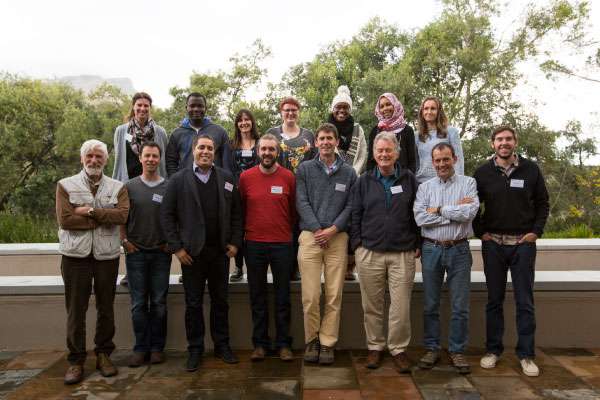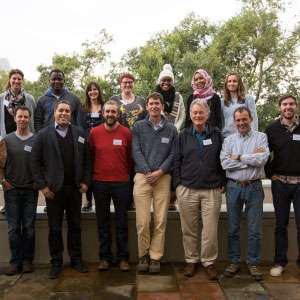Tsetse and Trypanosomiasis Modelling Workshop
July 4th, 2016
In the last week of June, fifteen scientists converged on Stellenbosch for a week-long intensive Workshop, hosted by SACEMA. The aim was for the researchers to share their knowledge of the problems and prospects associated with modelling the population dynamics of tsetse flies (Glossina spp) and the trypanosomes that they transmit in Africa to game animals, domestic livestock and humans. Visiting participants came from the Liverpool School of Tropical Medicine, the Roslin Institute in Edinburgh, and from the Universities of Cambridge, Cape Town, Free State, Texas and Warwick. The participants represented a range of disciplines – epidemiology, physiology, evolutionary ecology and mathematical biology – and included neophyte tsetse researchers through to those who have been in the field for up to 50 years.
The Workshop was funded through the WHO/TDR/IDRC programme: Human African Trypanosomiasis: alleviating the effects of climate change through understanding human-vector-parasite interactions and, accordingly, there was a considerable emphasis on the effects of climate, and particularly temperature, on the population dynamics of the vectors and the parasites. The event was a Workshop in the true sense of the word, with half of the second day, and large proportions of the last three days, being given over to Break-Out sessions where the participants formed ad hoc groups to work on problems of mutual interest. This provided the particularly important opportunity for the four graduate student attendees to interact with each of the more senior researchers.
The centrality of climate to the proceedings was emphasised by UCT’s Lisa van Aardenne’s analysis of data from Rekomitjie Research Station, in the Zambezi Valley of Zimbabwe, where meteorological records have been produced almost continuously over the past 57 years.
Mean daily maximum and minimum temperature have increased by 0.9°C and 1.7°C, respectively, since 1959, with the biggest increases in November at the end of the hot dry season. Glyn Vale showed that these temperature increases, and some extreme events, have been associated with declines of 80-98% in the tsetse populations around Rekomitjie. Vale’s Excel simulation studies produced results consistent with temperature-dependent increases in mortality among adult and, particularly, immature tsetse – resulting in the severe declines in tsetse populations already observed at Rekomitjie. It was suggested that the further increases in temperatures predicted for the next few decades will cause the tsetse populations at Rekomitjie to disappear, with G. pallidipes going before G. m. morsitans. The climate on higher ground in Zimbabwe will become more suitable for tsetse.
A variety of other modelling techniques were on display. Roux-Cil Ferreira presented an audacious attempt to develop an agent-based approach to the modelling of a very large mark-recapture data set from Zimbabwe. On the other hand, differential equation modelling techniques, applied both to tsetse and trypanosome biology, were presented by Rachid Ouifki, and the graduate students, Nada Abdelatif, Spencer Fox, Tokpa Jamah and Zinhle Mthombothi – most often using data from Zimbabwe. Similarly, in the east African context Paul Bessell modelled trypanosome dynamics in wild hosts, and Kat Rock gave two presentations on different aspects of modelling trypanosomiasis dynamics and control in countries like the DRC. Of particular importance in her presentations was the indication that vector control using simple, affordable “tiny targets” could be game changing in the battle against Gambian trypanosomiasis.
Sinead English, meanwhile, considered the consequences of maternal effects for tsetse population dynamics, trypanosome epidemiology and the evolutionary responses of tsetse to environmental change. John Hargrove provided an analysis of age-specific trypanosome prevalences found in tsetse at Rekomitjie. He also made a presentation on behalf of Sarah Ackley (UCSF), who was unable to attend the Workshop, but who has developed a differential equation modelling approach that promises to provide improved estimates of adult tsetse mortality from ovarian dissection data. Jennifer Lord presented work carried out both in Zimbabwe and Tanzania, addressing tsetse and trypanosome population dynamics at the edge of wildlife areas and, in particular, asking questions about the relationship between vector and host densities.
Given the large body of field work that has been carried out in Zimbabwe on tsetse and trypanosome biology, and on the development there of methods for the control of the vectors and the disease, there was a considerable emphasis at the Workshop on the analysis of results from Zimbabwe, and of application of models to those data. Stephen Torr reminded the meeting, however, that the biology of the riverine Palpalis group tsetse, and Gambian human sleeping sickness, typical of West Africa, present problems entirely different from those seen in eastern and southern Africa – both for the modeller and for the people tasked with controlling trypanosomiasis.
Finally, John Terblanche provided an entirely new and refreshing approach – viewing tsetse population dynamics through the lens of ecological energetics. He considered evolutionary trade-offs, links to other traits, such as water loss and reproductive output, and asked how we might integrate key traits of energetics into population dynamics models. The enthusiastic reception of his ideas by the meeting typified the open spirit of the Workshop and gives hope that the event will spur serious advances in the near future in the analysis of tsetse and trypanosome populations and in the further development of improved, economical, eco-friendly techniques for disease control. The Workshop has already given rise to new connections and collaborations, kicking off with a joint article currently being written by the participants, and a hope for an early reconvening of the group.

